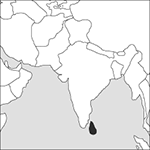
Source: MAPS IN MINUTES™ © RH Publications (1997)
Capital:
Colombo; Sri Jayewardenepura Kotte is the administrative capital
Area:
65,610 sq km (25,332 sq miles)
Population:
21,675,648 (2013 est)
Currency:
1 Sri Lankan rupee = 100 cents
Religions:
Buddhist 69.1%; Muslim 7.6%; Hindu 7.1%; Christian 6.2%
Ethnic Groups:
Sinhalese 73.8%; Moor 7.2%; Indian Tamil 4.6%; Sri Lankan Tamil 3.9%
Languages:
Sinhalese (official); Tamil; English
International Organizations:
UN; Commonwealth; Non-Aligned Movement; Colombo Plan; WTO
A pear-shaped island country in the Indian Ocean off the south-east coast of India.
Physical
Sri Lanka has very broad coastal plains which rise at the centre to highlands. The climate is monsoonal. At high altitudes there are forests, streams, and waterfalls. On the lower slopes tea is grown; and on the well-rivered plains there are rubber-trees, coconut palms, and paddy fields.
Economy
The large agricultural sector produces rice, sugar cane, grains, pulses, oilseed, vegetables, fruit, tea, rubber, and coconuts; processing these products is an important industry, and tea, spices, and rubber and coconut products are important exports. Other export industries include textiles, clothing, precious stones, and fish. Important service industries include telecommunications, insurance, banking, tourism, and IT services.
History
Sri Lanka’s early history was shaped by Indian influences and its modern identity by three phases of European colonization. The origins of the dominant Sinhalese racial group go back to Indo-Aryan invaders from north India, whose successors dominated the north central plain from the 5th century bc until about 1200 ad. During the 2nd century bc Buddhism spread, following the conversion of the reigning king. An outstanding ruler was Parakramabahu I (1153–86), who exercised strong military and administrative leadership and also reformed the quarrelling Buddhist sects. However, intermittent invasions from south India gradually created an enclave of Tamil Hindu power on the northern Jaffna peninsula and the north-eastern coast. The centre of Sinhalese and Buddhist civilization gradually shifted south-westwards, and political power was divided between a number of kingdoms.
European contacts began in the early 16th century when Portuguese merchants, profiting from the internal disunity, gained trading privileges on the west coast. Dutch traders gradually supplanted Portuguese influence in the 17th century, but were replaced by British forces in 1796. When the embattled interior kingdom of Kandy fell in 1815, the entire island came under the control of the British, who called it Ceylon. In the early 20th century the middle class was pressing for self-government. A new constitution was established in 1931, but racial tensions prevented its full implementation. The island, although now granted an element of self-government, remained a crown colony until 1948, when it was granted independence as a dominion within the Commonwealth of Nations. A government was established by the United National Party under Don Senanayake, who was succeeded (1952) by his son, Dudley Senanayake. The Socialist Sri Lanka Freedom Party was in power from 1956–1965, and Solomon Bandaranaike was its dominant force until his death in 1959. His widow, Sirimavo Bandaranaike, succeeded him as Prime Minister (1960–65; 1970–77; 1994–2000). A new constitution in 1972 established the island as the Republic of Sri Lanka. Tensions have re-emerged between the majority Sinhalese, traditionally Buddhist, and the minority Tamil, chiefly Hindu, who had come from southern India and live in northern Sri Lanka. A ceasefire was arranged by the Indian government in 1987 between Tamil guerrilla groups and the Sri Lankan government, but a tense situation remained. During 1989–90 President Ranasinghe Premadasa initiated all-party talks to end civil strife, but these again failed and in 1991 the Defence Minister was assassinated. A state of emergency was declared, but violations of human rights by government forces led to suspension of UK aid. During the years 1990–91 civil strife claimed some 12,000 lives. Although peace talks were again initiated in April 1992, they made little progress. Meanwhile the Sri Lankan economy rapidly declined. President Premadasa was assassinated in 1993. Chandrika Kumaratunga, daughter of Solomon and Sirimavo Bandaranaike, was elected Prime Minister in 1994. Later in the same year, Kumaratunga became President and was succeeded as Prime Minister by her mother. Peace negotiations and a ceasefire between the Government and Tamil guerrillas in 1994 were abandoned, and renewed fighting erupted in 1995. Despite a successful assault by government forces on the Tamil guerrilla stronghold in the Jaffna peninsula in the north of the island, fighting continued until a ceasefire was agreed in 2002. Peace talks began but were suspended in 2003. Sri Lanka was hit hard by the Indian Ocean tsunami, with 35,000 people being killed. In 2005 President Kumaratunga was succeeded by Mahinda Rajapaksa. The ceasefire with the Tamil guerrillas broke down in 2006 and the government secured a complete military victory in 2009. Rajapaksa was re-elected in 2010 but in the 2015 elections, he was surprisingly defeated by his former health minister, Maithripala Sirisena, who vowed to tackle the corruption and nepotism of Rajapaksa’s government and to transfer some presidential powers to parliament. He appointed Ranil Wickremesinghe as prime minister. Parties supportive of Sirisena won the August parliamentary elections, securing Wickremesinghe’s position and thwarting Rajapaksa’s hope to return as prime minister. In late 2015 the government announced that special courts would be established to look into war crimes. After two years of fast growth, the economy slowed in 2015 and the government was forced to seek financial help from the IMF.
- American Institute of Aeronautics and Astronautics
- American Institute of Chemical Engineers
- American Institute of Professional Geologists
- American National Standards Institute
- American Petroleum Institute
- American Province
- American Registry for Internet Numbers
- American Revolution
- American Society for Quality
- American Society for Testing Materials
- American Society of Mechanical Engineers
- American Standard Code for Information Interchange
- American Statistical Association
- American Statistician
- americium
- Amerindian
- Amersfoort
- amesite
- Ames Research Center
- Ames test
- surrogate variable
- surtax
- Surtseyan eruption
- survey
- survey data